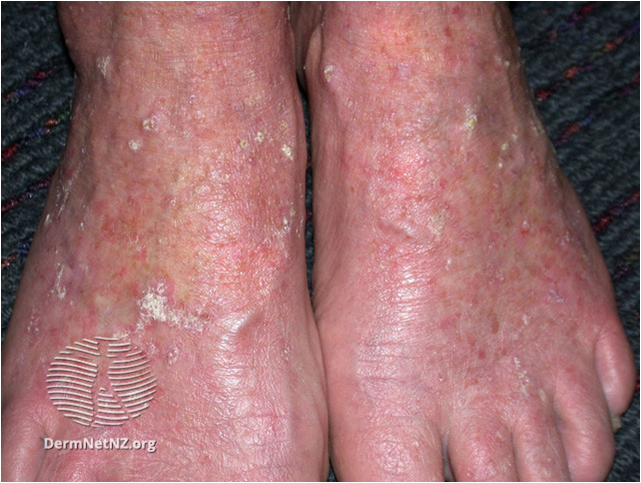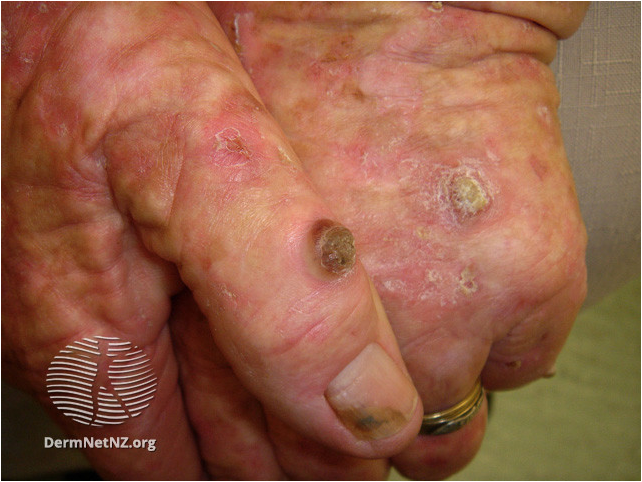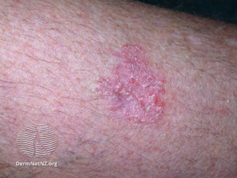Actinic (Solar) Keratoses
Actinic keratoses (AK) occur on sites of chronic sun exposure, the dorsum of the hands, face and scalp, especially in the fair-skinned. May present as:



- Face Telangiectasia: Photo Credits: DermNetNZ.org Source Link: https://dermnetnz.org/topics/actinic-keratosis-face-images
- Head Telangiectasia: Photo Credits: DermNetNZ.org Source Link: https://dermnetnz.org/topics/actinic-keratosis


- Feet Image : Photo Credits : DermNetNZ.org Source Link: https://dermnetnz.org/permission/image/11334

some Actinic Keratosis can be very Hyperkeratotic.
image from Search DermNet | DermNet (dermnetnz.org)
Bowens disease (SCC in-situ):
- Persistent, scaly non-thickened macules or patches, often asymptomatic, Variable size up to several centimetres. Common on lower legs in women.
- May be multiple.



R.C 18-05-23
Actinic keratoses (AK) are common and are due to chronic UV damage, commonly occurring on photo-exposed sites in the older population. There is no cure and the aim of treatment is to control AK numbers. Not all patients with AK will require treatment and prior to any treatment initiated a risk assessment should be made. All patients should be advised to use emollients and sunscreens (SPF 30+). Patients at a higher risk of developing keratinocyte cancers may require treatment. This includes patients who are immunosuppressed, have a history of invasive keratinocyte cancers and those with extensive disease (large areas of scalp/face).
Criteria for Dermatology Referral
Actinic Keratoses/IEC
- Diagnostic doubt
- Painful rapidly growing lesion (think SCC – refer urgently!)
- “High risk” disease
- Immunosuppressed patients
- Extensive disease involving large field areas (i.e. large areas of scalp/face)
- Previous invasive keratinocyte cancers
- Lack of response to treatment
- Bowens disease around nails/digits
Diagnostic Tips
Actinic Keratoses/Bowens
- Actinic keratoses are pre-malignant but transformation to invasive squamous cell carcinoma (SCC) is rare. Specific treatment is not essential, particularly in low risk disease.
- Suspect SCC if a lesion develops a thickened painful base or ulcerates
- Solitary cutaneous horns should be removed for histopathology if they are painful and have a broader base compared to their height
If suspicious follow pathway for squamous cell carcinoma
Management
ActinicKeratoses
General:
Sun protection advice/emollient – this is essential as there is evidence that sunblocks can clear AKs and reduce future risks.
Specific management options:
- Single or few scattered AK
- Generally no treatment indicated except for emollients and sunblocks. In patients with “high risk” disease (see criteria above) one could use the following:
- 5% 5-fluorouracil
- 0.5% 5-fluorouracil/salicylic acid
- 5% imiquimod cream
- Cryotherapy – infrequently used
- Curettage and cautery through local minor surgery (only when diagnostic doubt)
- Multiple (Field) AK
- 5% 5-fluorouracil
- 3.75% imiquimod cream
- Diclofenac gel 3%
- PDT – not currently available in NHS Lothian
- Long term management
- Patients may present with few scattered AK or large field change. However the majority will have microscopic disease and so if treatment is indicated the preference would be to treat field change, ideally with 5% 5-fluorouracil cream as first –line therapy. Patients are likely to need ongoing treatment and not just a single course due to the chronic nature of this condition. 5% 5-fluorouracil cream can be used as per licence indication but many patients are unable to tolerate the skin reaction so the frequency can be reduced to three times per week and given over a longer period of time. Most will require treatment over a three to six month period following which a re-assessment should be made. Treatment can be discontinued if there is an improvement but most patients will require re-treatment due to the chronic nature of AKs.
See BNF for dosing
Bowens disease
Bowens disease is common and due to chronic UV damage, commonly occurring on photo-exposed sites in the older population. There is no cure and the aim of treatment is to control lesion numbers. All patients should be advised to use emollients and sunscreens (SPF 30+).
Solitary/few lesions
- Topical 5% 5-fluorouracil cream
- Curettage – only where there is diagnostic doubt. Must be sent to pathology.
- Cryotherapy – may be suitable for small lesions if you are confident of the diagnosis.
Multiple lesions
- Topical 5% 5-fluorouracil cream
- PDT – not available in NHS Lothian
For Patients
PIL Actinic Keratosis
http://www.bad.org.uk/shared/get-file.ashx?id=66&itemtype=document
PIL IEC/Bowen’s Disease
http://www.bad.org.uk/shared/get-file.ashx?id=235&itemtype=document
PIL 5 Fluorouracil cream
http://www.bad.org.uk/shared/get-file. document fluorouracil cream (Efudix)
For Health Professionals
Link to PCDS Actinic/Solar Keratosis guidance
Link to PCDS Bowen’s Disease guidance
Dermnet NZ: http://www.dermnetnz.org/













